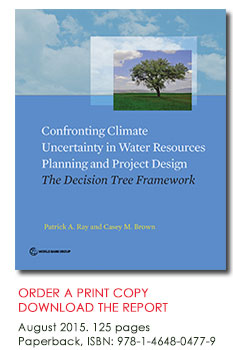
What water planners need to know about decision making under climate change
Today, with the earth warming faster than previously thought, large changes in temperature and precipitation have brought about even more uncertainty concerning the future of our water resources. The primary challenge of achieving water security is our ability to make decisions in the present that sufficiently account for the needs of the future. This becomes particularly important in water projects that involve investments in long-lived infrastructure, which must deliver benefits for many generations to come. 
Resilient infrastructure will enable countries to respond to floods and droughts, sea level rise, and unpredictable river runoff, and to bring clean and safe water to those currently without access. But how do we ensure that our investments are resilient to climate risks? How do we make climate-smart policy choices against a backdrop of uncertainty?
The Decision Tree Framework described inConfronting Climate Uncertainty in Water Resources Planning and Project Design provides resource-limited project planners and program managers with a cost-effective and effort-efficient, scientifically defensible, repeatable, and clear method for demonstrating the robustness of a project to climate change.
The framework adopts a “bottom-up” approach to risk assessment that aims at a thorough understanding of a project’s vulnerabilities to climate change in the context of other nonclimate uncertainties (for example, economic, environmental, demographic, or political). It helps to identify projects that perform well across a wide range of potential future climate conditions, as opposed to seeking solutions that are optimal in expected conditions but fragile to conditions deviating from the expected.




